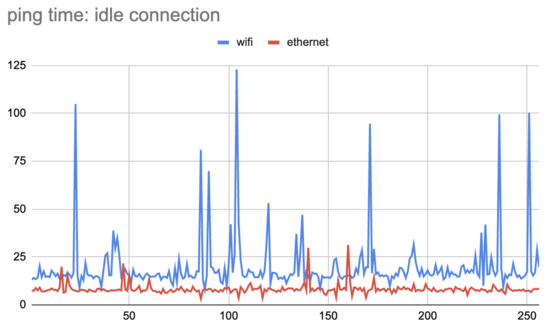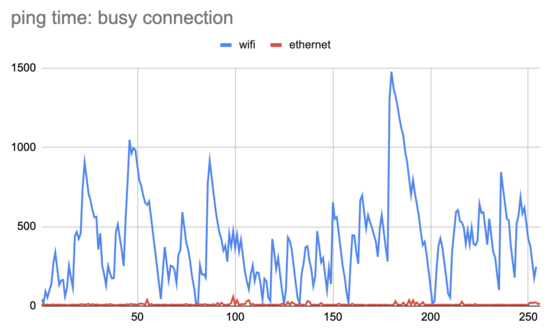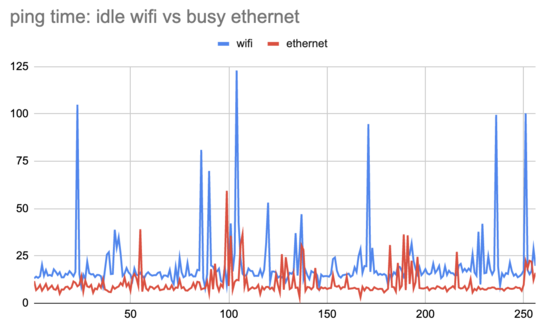Ethernet Is Worth It For Video Calls
post by jefftk (jkaufman) · 2020-04-11T12:10:02.409Z · LW · GW · 26 commentsContents
26 comments
I recently ran ethernet to my desk at home, and I've been really impressed with how much it helps for video calls. Not only are garbled sections less common, I'm finding us talking over each other less.
This makes a lot of sense: wifi's going to struggle more with latency (lag) because the radio spectrum is a noisy shared space. I think I hadn't realized how much of an effect a wired connection would have on latency, or how much better a video call is when latency is lower. This is essentially the same reason serious multiplayer gamers use wired connections, but I hadn't been thinking of it that way.
The professional way to run ethernet is to use a roll of ethernet cable, jacks, and a cable crimper. This lets you make very small holes, just the size of the cable. I don't have these, it's not a good time for borrowing things, and I didn't expect to be doing enough ethernet for it to be worth it to buy one. So I got a long enough cable for the whole run, erring on the "much too long" side, and made holes big enough for the cable and jack. I was very careful of the jack as I went, since if the jack got damaged I'd have needed to start over.
The router was three rooms away, and I could run the cable through the attic. I picked places at both ends that were relatively inconspicuous, poked nails up through the ceiling in each place, found the other ends of the nails in the attic, expanded the holes to be big enough for the cable, ran the cable, and cleaned up the dust. My laptop doesn't have an ethernet port, but I had an adapter. It took me about an hour from deciding to run the cable to having everything working.
While it's hard to quantify the effect on the calls, to check that I
wasn't imagining things I ran some latency tests with ping.
I picked an IP at my ISP and ran:
ping -c 256 -i 0.1 [IP]This tells my computer to send 256 packets to that IP, one every 100ms, and time how long they take to come back. First I tested on a relatively idle network, with my computer not doing anything and most of my housemates asleep:
You can see that ethernet is generally a bit better than wifi, with occasional blips, though even the blips aren't that bad. Then I tested on a heavily loaded connection, by visiting a page with enough images that it wouldn't finish downloading them before the test stopped:
Now you can see that wifi is really struggling, while ethernet is comparatively solid. In fact, heavily loaded ethernet does better than idle wifi:
Since you don't get the real benefits of a wired connection until both sides of the connection are wired, now I need to convince all my teammates to run ethernet.
Comment via: facebook
26 comments
Comments sorted by top scores.
comment by Matt Reyes (matt-reyes) · 2020-04-12T06:56:20.714Z · LW(p) · GW(p)
I have a family history of PC gaming, and we have done the " roll of cable, jacks, and crimper" method in every house I have lived in. If you want to avoid holes, you can run the cables on the floor along wall, and they will fit under most doors without impeding opening. another option is to put all your holes in the floors or ceilings of closets.
comment by Dagon · 2020-04-11T14:57:59.021Z · LW(p) · GW(p)
This is awesome. Noticing a problem and then actually measuring it is far too uncommon, thanks!
The end-advice (run ethernet for latency-sensitive uses) is reasonable, but it will vary greatly in how applicable it is. My large 1926 house in a residential area of Seattle has much higher barriers to running wires (lath and plaster walls, stucco exterior), and less interference with neighbors (less than a dozen SSIDs visible, none very strong). It's big enough that I put in a quality wired-mesh setup (Unifi equipment: highly recommended for geeks, probably recommend Nest or Eero if you don't enjoy this stuff. The key is to use ethernet to the stations where it's possible, and mesh only for radio extension) and have had no problems.
I tend to test latency in-house (ping the router) rather than to ISP, just to remove that variance. Ethernet gets very consistently under half a millisecond, and wifi under light load gets under 10ms, with occasional spikes up to 35ms, and under medium load (it never gets all that heavy; only 60Mbps internet, and 1Gbps to the local file server) may hit a few hundred. I don't ever think I've seen over half a second, let alone 1500ms.
You can probably get MOST of the benefit by having a hybrid solution - not every device needs to be wired, but you should wire the hungriest if you can, and wire multiple access points across the space, so that each radio only has to serve a subset of devices. Many routers also have reporting available for which devices are using how much bandwidth, to identify the ones that should move to wired (or to a different radio, or set up throttling so there's room for others).
Replies from: stuart-anderson↑ comment by Stuart Anderson (stuart-anderson) · 2020-04-12T00:30:23.992Z · LW(p) · GW(p)
-
comment by Raemon · 2020-04-11T19:51:52.683Z · LW(p) · GW(p)
This reminds me of a complaint somewhat made recently about cell phones – later-stage millennials tend to prefer texts over phone calls. At least part of this may be because millennials are used to crappy cell phone services, where you're constantly cutting out, hard to hear, and otherwise dealing with hiccups that make it a bad experience, whereas the previous generation had actual high quality landlines.
Replies from: Kenny↑ comment by Kenny · 2020-04-11T22:08:03.966Z · LW(p) · GW(p)
I think I am probably an 'early-stage' millennial and I prefer texts over phone calls mainly because the former are (roughly) asynchronous. But I think I also have an aversion to phone calls because of the general poor quality you mention. Having access to a 'phone booth' is wonderful. Having good WiFi also helps (IIRC).
One of the nice features of the old landline network is that bandwidth was (much more) 'guaranteed'. I remember one reason why high speed Internet access via cable (TV) networks sometimes sucked (relatively) was because all of the customers in a small area shared fixed bandwidth, e.g. if too many people used the Internet at the same time, it'd be slower for everyone.
I think nowadays, a lot of home phone service is really VOIP, i.e. over a regular Internet connection.
Is the old telephone network still being maintained? Redundancy sure feels valuable currently, so I wonder if it might be valuable to try (more) to preserve it.
Replies from: stuart-anderson, Kenoubi↑ comment by Stuart Anderson (stuart-anderson) · 2020-04-12T00:48:02.870Z · LW(p) · GW(p)
-
Replies from: Kenny↑ comment by Kenny · 2020-04-12T07:33:23.944Z · LW(p) · GW(p)
Yes, not having to talk to, or chat with, a person at all is preferable! Sadly, there seems to be enough friction on people publishing and maintaining info available otherwise that it's not always possible.
I would think the fact that the copper networks already exist (where they haven't been neglected or even removed) would make them a potentially redundant alternative. One reason why wireless doesn't seem as useful is that private individuals don't ever think or act in terms of a single 'cell'. What good would that be generally? I can understand why it might be useful for emergency workers, but not for anyone else.
↑ comment by Kenoubi · 2020-04-12T02:12:14.594Z · LW(p) · GW(p)
Asynchronicity is not always better than synchronicity. I would encourage you to think about the cases in which each could be better than the other.
Replies from: Kenny↑ comment by Kenny · 2020-04-12T07:24:40.433Z · LW(p) · GW(p)
I agree and I have thought about that – a lot!
Phone calls are my main form of synchronous communication aside from face-to-face conversations; sometimes chat and even much more relatively rarely, text messages. One thing that I've discovered about myself is that, because I often do participate in phone calls with people I like a lot (e.g. people I find interesting) that I don't often see regularly in-person, I reasonably expect any phone call to take a lot of time. And because I anticipate calls to last a relatively long amount of time, there's a significant 'activation energy' that I have to be willing to provide to willingly call someone or even answer their call. Ironically, this often leads to less frequent calls and even greater activation energy eventually required.
Another thing I discovered that is relatively idiosyncratic to me is that I like writing, I like reading, and I'm confident that I can explain even fairly complicated ideas clearly. I have often been annoyed by people calling me after several back-and-forth emails. I certainly understand the impulse tho as I have done that myself when I thought that someone was not providing sufficient context in writing. I'm much more understanding of people have differing preferences, and even capabilities, with respect to different forms of communication.
Synchronous communication is, assuming good faith among all participants, much more likely to more rapidly converge to mutual understanding. But it's relatively costly. Everyone has to be available at the same time, and possibly at the same place. Demands or requests for synchronous communication can potentially (and often do) interrupt other activity, which can be pretty expensive even if the demand is refused or the request denied, depending on the activity.
One of the most significant benefits of asynchronous communication – in my preferences – is that, because the communication has to be buffered or queued, there's a record of it that I can access and potentially save to access arbitrarily later. I often have to interrupt important synchronous communications to take notes or remind myself of some commitment I've made in the course of that communication. That's generally much easier to handle with asynchronous communications.
Replies from: Kenoubi↑ comment by Kenoubi · 2020-04-13T19:48:55.592Z · LW(p) · GW(p)
OK. I think LWers (up to some years ago including myself) and millenials (which I am not; I'm 38) tend to overestimate the benefits and underestimate the drawbacks of asynchronous communications. I also prefer not being interrupted and having a record of what I've talked about, all else being equal, but it seems kind of ridiculous to me that I have to actively tell people "just make a damn phone call" when they need a response to something within 5 minutes. As long as you're actually considering which one to use each time, you're probably fine.
(Also, the lack of records of synchronous communications seems like largely a solvable technical problem, and is sometimes a feature rather than a bug, if one doesn't want those records to be shared with certain audiences and doesn't want to spend the effort to properly secure them.)
Replies from: Kenny↑ comment by Kenny · 2020-04-13T23:46:11.556Z · LW(p) · GW(p)
I'm 38 too! I thought I was a millennial, at least under some definitions.
... it seems kind of ridiculous to me that I have to actively tell people "just make a damn phone call" when they need a response to something within 5 minutes.
I agree with this! We probably don't disagree as much you seemed to think. For my most common forms of asynchronous communication, my own personal commitment is roughly to respond with 24 hours. For some chat messages, I'll potentially respond more quickly. Sometimes I don't respond to a text or a missed call for several days. I definitely don't commit to answering letters or cards more quickly than several multiples of the 'lag' (e.g. several days) either.
Also, the lack of records of synchronous communications seems like largely a solvable technical problem
A audio or video recording is much less useful than text records (accessible via computer). Searching alone is much harder. Even text messages, which I can't as easily access from my computer, are less useful for that reason than emails.
I do agree that non-records can be useful. I appreciate that, generally, my face to face conversations aren't recorded, and thus need to be secured as you mentioned. But I also lament that lack of records for some conversations as well.
Replies from: Kenoubi↑ comment by Kenoubi · 2020-04-14T18:59:38.880Z · LW(p) · GW(p)
A audio or video recording is much less useful than text records (accessible via computer). Searching alone is much harder. Even text messages, which I can't as easily access from my computer, are less useful for that reason than emails.
Audio to text transcription is really quite good these days. I didn't mean to say it was a solved problem... just that the reason it isn't is not a lack of the basic technological capabilities required.
comment by Steve Fortney · 2020-07-18T18:05:09.038Z · LW(p) · GW(p)
I participate in a lot of VA video conferences with my counselors as a result of the Covid situation. Many of my counselors now work from home and our calls sometimes end on the phone because of the loss of video and audio breakup. This does not happen with everyone. When both people live "In town", this in West Virginia, my meetings are usually fine, when the other individual is not in town is the time when most of the calls run into problems. I ran a Cat6a cable between my modem and laptop which made a great difference overall to my system, but the calls still sometimes drop. I believe that, please tell me if I am wrong, if the equipment, signal strength, etc. are not strong on both ends then the call will fail. The conference will only be as successful as the weakest system.
Have a Great one!
Steve Fortney
Replies from: jkaufman↑ comment by jefftk (jkaufman) · 2020-07-18T20:48:54.348Z · LW(p) · GW(p)
The conference will only be as successful as the weakest system.
That sounds right. The VC is a chain of components running from your mic and camera, through your computer, your wired connection, your ISP, the internet backbone, their ISP, their Wi-Fi/cables, their computer, and eventually their screen and speakers. If any of those flake out that will interrupt the call.
comment by Shmi (shminux) · 2020-04-12T03:29:49.075Z · LW(p) · GW(p)
Back in 2001 I was working on an 802.11a implementation, and the standard made a huge deal of supporting guaranteed quality of service. I don't think any of these features ended up being used by most consumer-grade base stations or subscriber stations, hence the spikes of latency and marginal streaming properties.
Replies from: jkaufman↑ comment by jefftk (jkaufman) · 2020-04-12T11:20:33.066Z · LW(p) · GW(p)
I don't see how you can guarantee quality of service in a noisy shared medium? Sometimes someone else will be transmitting, or running a microwave, and it will be briefly unusable, no?
Replies from: clone of saturn↑ comment by clone of saturn · 2020-04-12T16:54:07.167Z · LW(p) · GW(p)
Nothing can be done about external interference like microwaves, but the base station can allocate time slots where lower priority traffic is not allowed to be sent.
Replies from: jkaufman↑ comment by jefftk (jkaufman) · 2020-04-12T18:03:13.423Z · LW(p) · GW(p)
Makes sense; mostly I was confused by your use of "guarantee".
I'm curious how much of a difference this makes: if my base station were optimally allocating slots to prioritize voice calls how much of the way to "as good as wired ethernet" does that get me? Is most of the problem interference (I count 20 SSID in my "choose network" dropdown right now) or prioritization?
comment by Cory K (cory-k) · 2020-04-17T16:48:10.023Z · LW(p) · GW(p)
The things you crimp on the ends of cables are plugs. Pros do not run cables through walls and crimp plugs on them. They are punched down on wall or surface mount jacks (socket not plug) on the client end and punched down on a patch panel on the distro end - surface or wall jacks could be used too in pinch if one only needs a few. Solid wire is meant to be punched down for fixed infrastructure wiring as repeated flexing will damage the cable and stranded wire for patch cables meant for plugs to be crimped on.
Replies from: jkaufman↑ comment by jefftk (jkaufman) · 2020-04-13T01:03:54.576Z · LW(p) · GW(p)
I can't tell where you disagree with what I've written, except that "jack" means the socket and not the plug?
comment by Donald Hobson (donald-hobson) · 2020-04-12T11:44:06.412Z · LW(p) · GW(p)
I think that this would depend on other aspects of your setup. If you have a high speed fiber connection to your router, and you are surrounded by other peoples routers, ethernet will improve your ping times. If you have a bad copper connection to your router, and no other Wi-Fi hotspots nearby, then ethernet might be improving away from the bottleneck. Try pinging another device on the same wifi network, vs pinging an external site.
comment by Daniel Walker (daniel-walker) · 2020-04-17T16:48:16.376Z · LW(p) · GW(p)
Must not play many MMORPG. Of course wired internet is faster and more stable than wireless. One is a solid connection. The other floats through the air and through solid walls.


